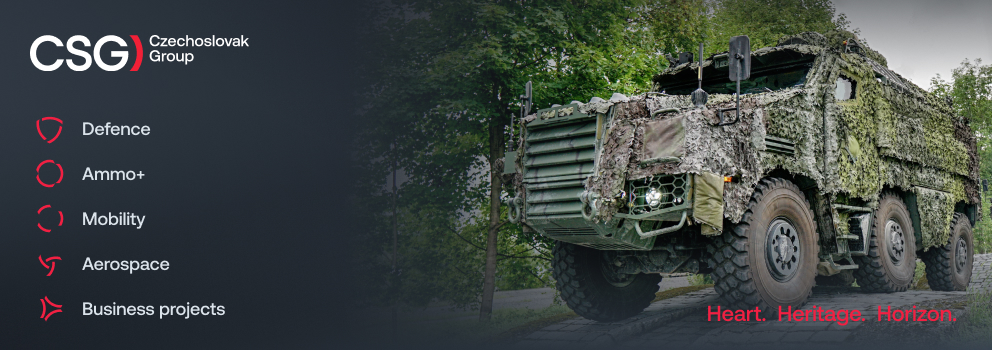120 mm self-propelled mortars for the Czech Armed Forces - more and more possible solutions
The Concept of the Czech Army Construction 2035, approved at the end of last year, again postponed the acquisition project of self-propelled mortars for several years - although it is an important part of the armament of brigade task forces, both heavy and medium type. Thus, the Army will continue to rely on towed mortars of the vz. 82 PRAM-L or PRAM-S on the extended chassis of the BVP. In the meantime, new interesting solutions are appearing on the market, which we will take a closer look at in this article.

To begin with, let us recall the known baseline requirements of the Czech Armed Forces for the 120 mm self-propelled mortar system as defined in 2018. The Army requires 62 self-propelled mortars, a crew of 4, an autonomous weapons suite, and a 25-year life cycle. An important requirement is then the ability to conduct semi-direct and direct fire, which defines a solution in the form of placing the main weapon in the turret and not the previously widespread solution called in the trusses. The platform is not explicitly defined, but from the simple fact that the self-propelled mortars will be intended for mortar platoons of both the 7th Mechanised Brigade and the 4th Rapid Deployment Brigade, it is logical to conclude that at least part of them will be on wheeled chassis. For the 7th Mechanised Brigade, then, the possibility of using the CV90 platform (to which the brigade is about to rearm) comes into consideration, but this would in practice mean essentially two formally independent acquisition processes - and in terms of maintenance and deployment logistics, obvious advantages but also disadvantages.
A very likely and in a way logical solution remains the use of the Pandur II 8x8 CZ platform. In the KBVP variant, these vehicles serving in the Czech Armed Forces will undergo a so-called mid-life upgrade, and a replacement of the remote-controlled weapon station with a combat turret is envisaged. In the self-propelled mortar variant, as regards turrets equipped with a 120mm mortar that meets the army's requirement for semi-direct and direct fire, either the Polish M120K RAK self-propelled mortar turret (in Poland on the Rosomak or Patria platform), a solution derived from the 2S1 Gvozdika self-propelled howitzer, or the Finnish NEMO system from Patria (in cooperation with Kongsberg) is under consideration.
Modernised mortar RAK
Currently, HSW and WB Electronics have developed a new turret for RAK mortars with twice the rate of fire (now about 15 rounds per minute). The turret uses a new automatic ammunition feeding system combined with a modified barrel design, digital fire control technology and automatically uses information from reconnaissance drones, new navigation systems and digital data transmission. Experience from the deployment of the system in Ukraine has been applied in the development of the new turret. Although it is a very interesting solution, it would be rather surprising if the Army would follow this Polish path.

Proven NEMO mortar
A subtler variant of the Patria 6x6 wheeled armoured vehicle (recently acquired by the Swedish Army) is also fitted with the NEMO system, and it can be assumed that this solution will be more easily applied to the Czech Pandurs 8x8, which are smaller and lighter than the Polish Rosomak vehicles (based on the Patria 8x8). The NEMO system will now also be relied upon by the US Army, which has a prototype variant of its tracked armoured multi-purpose vehicle AMPV from BAE Systems. The NEMO system on this prototype is equipped with a highly automated fire control system that allows it to conduct multiple simultaneous impact (MRSI) firing missions and, according to Patria, is capable of hitting a target with up to six missiles simultaneously. The US Army is about to subject the aforementioned AMPV Turreted Mortar prototype to a thorough field evaluation, when this experience can then be inspirational for the Czech Army.

Israeli news - Crossbow
In September 2023, the Crossbow system from the Israeli company Elbit Systems was presented at the DSEI international trade fair in London. This system is fully automated and is linked to a fire control system that communicates with the battle management system. When a firing order is given, the vehicle stops and the mortar is ready to fire, with the first round being fired in less than 30 seconds. Automatic reloading allows 10 rounds to be fired in the first minute, with a sustained rate of fire of 6 rounds per minute. The barrel is 3 metres long and has a range of around 10 km, including MRSI capability (at a range of 2.5-5 km). It can fire all standard 120mm ammunition and can also fire on the move. The turret has a -3° to 87° bearing, allowing direct fire.

The solution in the form of the Crossbow system, which seems to match the requirements of the Czech Armed Forces well, brings with it another potential advantage. The aforementioned modernisation of the KBVP Pandur II 8x8 CZ by Tatra Defence Vehicle can go the way of the Pandur II 8x8 EVO with the UT30 MK2 turret produced by the Israeli company Elbit Systems, similar to the Crossbow. However, the decision is not yet made, there are more possible solutions for Pandurs of the 4th Rapid Deployment Brigade and they are beyond the scope of this article, but the affinity of UT30 MK2 and Crossbow is certainly an interesting point worthy of attention.
Slovak project AM120
It is also worth mentioning the new Slovak project of the 120mm self-propelled mortar AM120 by ZTS Speciál on the Tatra 815-7 6x6 chassis with armoured cab Puma L2 Long, where AM stands for "automatic mortar". Its massive autonomous turret can be mounted on a wide range of chassis with remote control from the vehicle cab. The turret has an elevation range of 40° to 80° (which is problematic for the Army's requirements - the system is not designed for direct fire) and a full 360° range; the minimum range is 504 metres, the maximum 8200 metres, and the AM120 boasts an impressive cadence of 18-20 rounds per minute.

The Slovak company Kerametal, which supplies the fire control system, and the Czech company Czechoslovak Group, which supplies the chassis and cabin, are involved in its development. The system is making its public debut at the IDEB 2024 international trade fair in Bratislava, which is currently underway.

The requirements of the Army of the Czech Republic mentioned in the introduction were already publicly communicated in June 2018. That is, six years ago, long before the armed forces could begin to evaluate the experience of the unexpected, but already more than two years of ongoing symmetrical high-intensity conflict in Ukraine. Since then, the acquisition of self-propelled mortars for the AFU has been postponed twice. The current ACSR 2035 does not envisage it until after 2031, so it is uncertain what form the project will take and whether the required specification will change in response to battlefield experience and technology development. For example, whether the Czech Armed Forces will eventually decide to copy the Slovak approach (i.e. to procure the CV90 as a self-propelled mortar for a heavy brigade), or whether it will continue to insist on a direct fire capability (if it were to abandon it, there would be many more potential solutions).
Zdroj: EDR Magazine, radar.rp.pl, Patria, futurearmy.sk






















